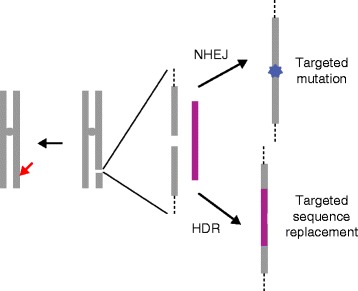Fig. 1.

Illustration of the repair consequences of targeted DNA cleavage. The red arrow represents the targeted break at a single chromosomal site made by CRISPR-Cas (or zinc-finger nucleases (ZFNs) or transcription activator-like effector nucleases (TALENs)). The expanded view shows the break in the presence of a repair template (magenta). The break can be repaired by non-homologous end joining (NHEJ), leading to local insertions and deletions (indels) (blue star), or by homology-directed repair (HDR), incorporating sequences from the donor template. In most eukaryotic cells, NHEJ predominates, even in the presence of a homologous template. Because correction with donor sequences is often desired, considerable research is currently directed toward altering that balance
